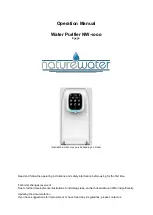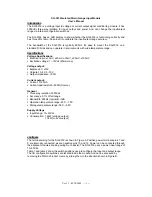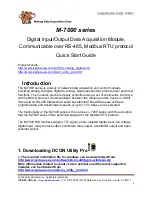
34 – Part 3: Solar water heater system installation
Part 4: Maintenance – 35
Maintenance check list
A properly maintained solar water heating system can provide years of dependable trouble free service. It is suggested that a
routine preventive maintenance program be established and followed by the end user with his contractor. Listed below is the
maintenance check list that outlines the primary components of the solar system that need to be inspected annually.
Propylene glycol – It is very important that the quality of the propylene glycol heat transfer fluid is maintained to
avoid damage to the collector loop and related components which come in contact with the fluid. See the propylene
glycol Data Sheet located in the back of the manual for further details.
Water quality can effect the operation of the solar heat exchanger over time. In very hard water areas, it is
recommended you drain a few gallons of water from the storage tank to keep the bottom of the tank free of
sediment.
Inspect and clean the solar collectors of any dirt, leaves, debris or film that may have settled on the surface and may
effect the performance. Clean by spraying with a pressurized water hose only.
Check Insulation for deterioration.
Check solar tank sensors and the boiler back up aquastat sensors to assure that they are secure and have not moved
or loosened.
Inspect the T&P valve on the water heater. Lift the release handle lever and make sure discharge is directed to an
open drain. Always remove sediment from tank prior to testing T&P valve.
The area near the water heater must be kept free of flammable liquids such as gasoline, paint thinners, adhesive or
other combustible materials.
The electric element may need cleaning – A hissing sound while operating will happen when the element starts to
build up deposits that will require cleaning. This should be done only by a qualified individual or licensed plumber.
Anode rod Inspection – The anode rod should be removed from the water heater tank annually for inspection. If the
anode core wire is exposed more than few inches it is recommended that the anode rod be replaced. It is important
to turn off the power to the heater and run water until it is cold, then drain tank and replace the anode rod.
!
CAUTION
If the heating element needs replacement, it is VERY important to use the same voltage, wattage and construction.
Shut down procedures
The solar system is designed to be easily isolated for emergency repairs or routine maintenance. To isolate the water heater,
simply shut down the supply water shut off valve which isolates the water heater from the pressurized cold water supply. The
collector loop can be isolated from the solar storage tank by closing the collector array “hot” and “cold” line isolation valves. If
the pressure in this loop drops or you find a glycol leak, close these valves and turn the circulating pump off by shutting down
the power to the control, then contact your installation contractor.
Vacation planning
Solar water heaters can build up very high temperatures when there is no daily draw on the system. Your VELUX solar water
heating system controller is programmed to protect your system from overheating. When leaving your home for extended
periods of time, no special shut down procedures are required. The best way to protect your system is to make sure power is
always on and to keep the system in normal operating mode. . The system controller will use the collectors to radiate heat back
to the atmosphere , preventing the system from stagnating at very high temperatures.
Part 4: Maintenance
















































